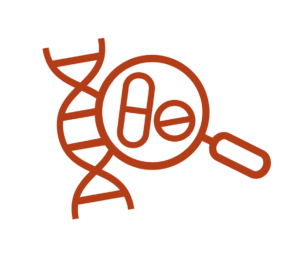
Frisell O, Malmberg C, Karadak A, Wahlberg K
Värdet av tidig och bred genomisk tumörprofilering i svensk cancervård – en hälsoekonomisk analys
The report is written in Swedish with a summary in English
Precision health involves an increased focus on individualized care in which treatment and diagnostics are adapted to the patient’s specific biological characteristics. Precision medicine, a component of this broader concept, includes both diagnostic methods and targeted treatments based on the tumour’s molecular profile. In the cancer field, development has progressed rapidly, particularly due to advanced sequencing technologies (Next Generation Sequencing, NGS), which enable analysis of large parts of the genome using gene panels at a reasonable cost. These panels may include anything from a few dozen to several hundred genes, such as the GMS-560 panel comprising roughly 560 cancer-associated genes.
For many cancer types, treatments targeting specific genetic alterations in tumour DNA are now available. This increases the need for genetic diagnostics to identify which patients can benefit from such targeted therapies. At the same time, NGS costs have decreased, making broad panels competitive even when only a small number of genes are of primary clinical relevance. Additionally, broad genomic data generate significant research value in both clinical and academic settings.
In lung cancer, the development of targeted therapies is most advanced, particularly in metastatic disease, and broad panel diagnostics are already recommended in the Swedish national treatment guidelines. Several targeted drugs are also being introduced for earlier disease stages. In breast cancer, development has been slower, but the first treatment based on tumour DNA has now been approved for metastatic disease. An increasing number of genes linked to prognosis and treatment resistance have also been identified, suggesting a future need for broader genetic analysis. Karolinska University Hospital has recently decided to implement broad panel diagnostics for metastatic breast cancer, a practice likely to become more common elsewhere, although short-term adoption will likely remain concentrated at university hospitals.
This analysis consists of two parts. The first is an interview study involving clinicians, policy stakeholders, and patient representatives, who overall expressed a positive attitude toward broad genetic diagnostics. They highlighted benefits such as improved clinical understanding, better identification of patients for clinical trials, and increased research potential. At the same time, several challenges were noted: insufficient technical infrastructure and capacity to manage large data volumes, a lack of expertise in fields such as bioinformatics and biomedical analysis, and risks of unequal access to care and inadequate patient information.
The second part, the health economic analysis, had two components. First, it examined the required survival benefit at different levels of increased healthcare costs for broad panels to be considered cost-effective (based on a willingness-to-pay threshold of 1 million SEK per QALY) in breast cancer. Second, it estimated the total healthcare costs associated with implementing broad panel diagnostics over one year for both breast and lung cancer.
In breast cancer, the model showed that a cost increase of 10–50% would require a survival gain of approximately 5%–17%. For a cohort of 334 women, broad panels were estimated to lead to an incremental cost of around 20.5 million SEK, of which 7.5 million SEK were analysis costs. The model predicted a gain of 41.5 QALYs, corresponding to an ICER of about 0.5 million SEK per QALY which is below the assumed threshold for cost-effectiveness in the base case.
For lung cancer, costs increased by roughly 90 million SEK compared with no genetic diagnostics and by 14 million SEK compared with traditional methods. Despite this, diagnostic costs accounted for only 1.8% of the total costs, which were dominated by pharmaceuticals and other treatments.
Overall, the results suggest that broad gene panels may be cost-effective and create value for patients, healthcare systems, and research, but implementation is likely to require investments in infrastructure, expertise, and new financing models.
For more information please contact Oskar Frisell
IHE RAPPORT 2025:16, IHE: Lund

